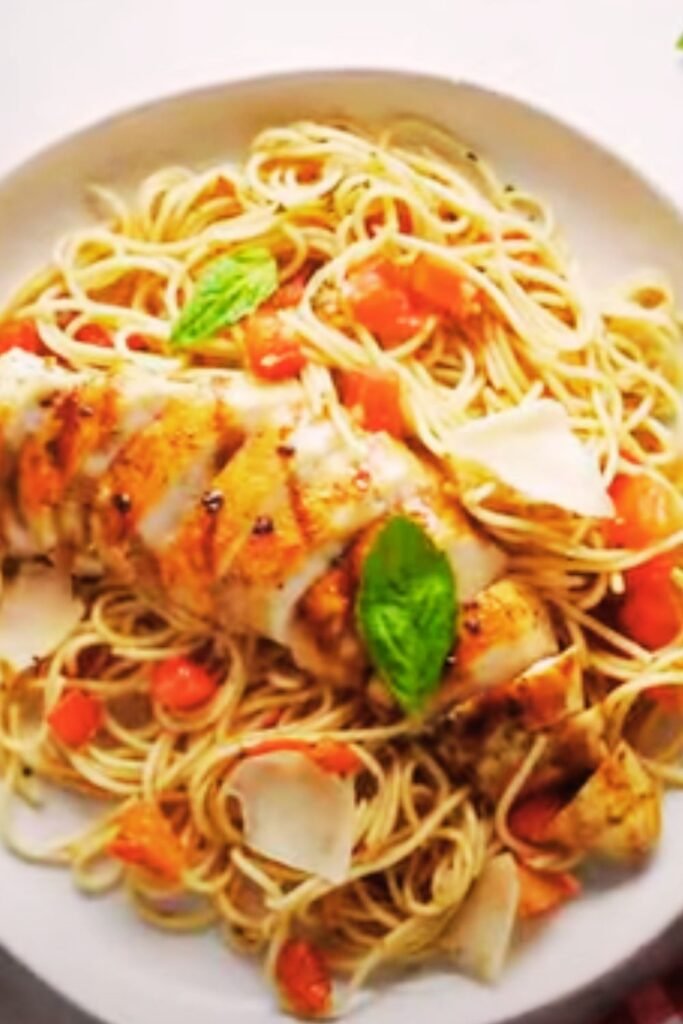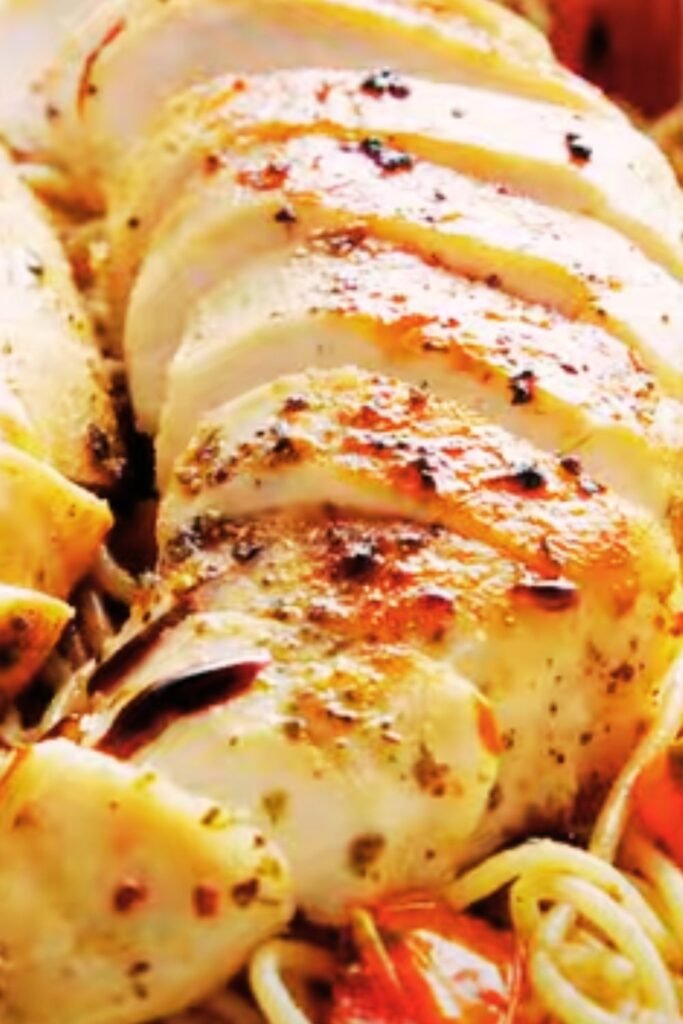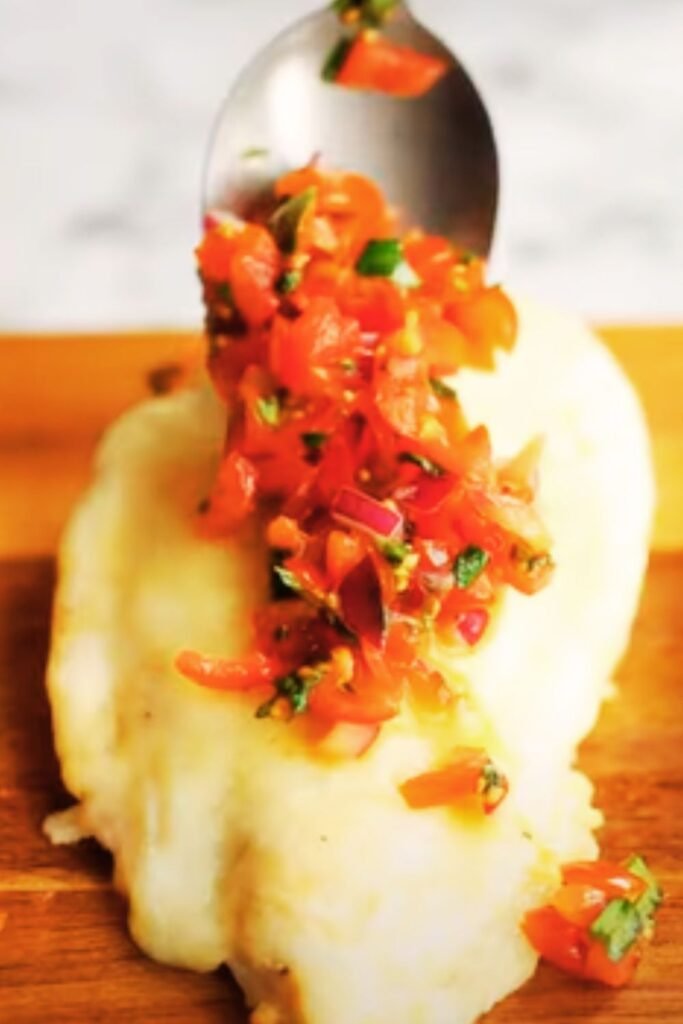When I first discovered the magic of combining bruschetta flavors with tender chicken and perfectly cooked pasta, I knew I had stumbled upon something extraordinary. This Bruschetta Chicken Pasta recipe has become my go-to dish for weeknight dinners, special occasions, and whenever I want to impress guests with minimal effort but maximum flavor.
The beauty of this dish lies in its perfect marriage of Italian traditions – the fresh, vibrant flavors of classic bruschetta topping combined with succulent chicken breast and al dente pasta. What makes this recipe particularly special is how it transforms simple, everyday ingredients into something that tastes like it came straight from a high-end Italian restaurant.
I’ve spent countless hours perfecting this recipe, testing different pasta shapes, experimenting with various cooking techniques for the chicken, and fine-tuning the balance of flavors in the bruschetta mixture. The result is a dish that’s both sophisticated enough for entertaining and simple enough for busy weeknights.
Understanding Bruschetta: The Foundation of Flavor
Bruschetta : A traditional Italian appetizer consisting of grilled bread topped with fresh tomatoes, garlic, basil, and olive oil, originating from central Italy.
Al Dente : The ideal texture for pasta, meaning “to the tooth” in Italian, where pasta is cooked until it’s tender but still has a slight firmness when bitten.
Mirepoix : A mixture of diced vegetables (typically onions, carrots, and celery) used as a flavor base in cooking, though in this recipe we focus primarily on onions and garlic.
The traditional bruschetta mixture serves as the flavor foundation for this pasta dish. Instead of serving it on bread, we’re incorporating those same fresh, vibrant flavors directly into our pasta sauce. This approach allows the tomatoes, garlic, and basil to meld beautifully with the chicken and pasta, creating a cohesive dish that’s bursting with Mediterranean flavors.
Essential Ingredients and Their Roles
| Ingredient | Quantity | Purpose | Substitution Options |
|---|---|---|---|
| Boneless Chicken Breasts | 1.5 lbs | Main protein, provides substance | Chicken thighs, turkey breast |
| Penne Pasta | 12 oz | Carbohydrate base, holds sauce well | Rigatoni, fusilli, bow-tie pasta |
| Roma Tomatoes | 6 large | Fresh flavor base, provides acidity | Cherry tomatoes, canned diced tomatoes |
| Fresh Basil | 1/2 cup chopped | Aromatic herb, authentic Italian flavor | Dried basil (1 tbsp), fresh oregano |
| Garlic Cloves | 6 cloves | Flavor foundation, aromatic base | Garlic powder (2 tsp), garlic paste |
| Extra Virgin Olive Oil | 1/4 cup | Cooking medium, flavor enhancer | Avocado oil, vegetable oil |
| Balsamic Vinegar | 2 tbsp | Acidity balance, depth of flavor | Red wine vinegar, white wine vinegar |
| Mozzarella Cheese | 8 oz fresh | Creamy texture, mild flavor | Provolone, fontina, goat cheese |
| Parmesan Cheese | 1/2 cup grated | Sharp flavor, authentic Italian taste | Pecorino Romano, aged cheddar |
| Red Onion | 1 medium | Sweet flavor, color contrast | Yellow onion, shallots |

Step-by-Step Cooking Instructions
Preparing the Chicken
My technique for perfectly cooked chicken begins with proper preparation. I always start by pounding the chicken breasts to an even thickness of about 3/4 inch. This ensures uniform cooking and prevents the dreaded dry, overcooked exterior with undercooked center.
Season the chicken generously with salt, black pepper, and a pinch of Italian seasoning. I let the seasoned chicken rest at room temperature for about 15 minutes while I prepare other ingredients. This brief resting period allows the seasoning to penetrate the meat and brings the chicken closer to room temperature for more even cooking.
Heat 2 tablespoons of olive oil in a large skillet over medium-high heat. When the oil shimmers but doesn’t smoke, carefully place the chicken breasts in the pan. I resist the urge to move them around – letting them develop a beautiful golden crust takes patience, but it’s worth it for both flavor and presentation.
Cook the chicken for 6-7 minutes on the first side, then flip and cook for another 5-6 minutes until the internal temperature reaches 165°F. Remove the chicken from the pan and let it rest on a cutting board while you prepare the pasta and sauce. After resting, slice the chicken into strips or bite-sized pieces.
Cooking the Perfect Pasta
I always use a large pot with plenty of salted water for cooking pasta. The general rule I follow is to use about 1 tablespoon of salt per gallon of water. This might seem like a lot, but properly salted pasta water is crucial for well-seasoned pasta.
Bring the water to a rolling boil before adding the pasta. I prefer penne for this dish because its tube shape holds the chunky bruschetta mixture beautifully, but rigatoni or fusilli work equally well.
Cook the pasta according to package directions, but aim for al dente texture. I usually start testing the pasta about 2 minutes before the package suggests. Reserve 1 cup of the starchy pasta cooking water before draining – this liquid gold will help bind your sauce and create the perfect consistency.
Creating the Bruschetta Mixture
While the pasta cooks, I prepare the fresh bruschetta mixture that makes this dish so special. Start by dicing the Roma tomatoes into small, uniform pieces. I prefer to remove the seeds and excess juice to prevent the dish from becoming watery, but some people enjoy the extra moisture.
Mince the garlic finely – I use a microplane grater for the smoothest texture. Dice the red onion into small pieces, roughly the same size as your tomato pieces for visual consistency.
In a large mixing bowl, combine the diced tomatoes, minced garlic, diced red onion, and chopped fresh basil. Drizzle with the remaining olive oil and balsamic vinegar, then season with salt and freshly cracked black pepper. Toss everything together gently and let it sit while you finish the pasta. This resting time allows the flavors to meld and intensify.

Bringing It All Together
In the same skillet where you cooked the chicken (don’t clean it – those browned bits add incredible flavor), add the drained pasta and the bruschetta mixture. Toss everything together over medium heat for 2-3 minutes, allowing the pasta to absorb some of the flavors.
Add the sliced chicken back to the pan along with cubes of fresh mozzarella. The residual heat will begin to melt the cheese, creating creamy pockets throughout the dish. If the mixture seems dry, add some of the reserved pasta water, a little at a time, until you achieve the desired consistency.
Remove the pan from heat and fold in half of the grated Parmesan cheese. Taste and adjust seasoning with salt, pepper, and additional basil if needed.
Nutritional Information and Health Benefits
| Nutrient | Per Serving (6 servings) | Daily Value % |
|---|---|---|
| Calories | 485 | 24% |
| Protein | 34g | 68% |
| Carbohydrates | 52g | 17% |
| Fat | 16g | 25% |
| Fiber | 3g | 12% |
| Sodium | 680mg | 30% |
| Calcium | 280mg | 28% |
| Iron | 3.5mg | 19% |
| Vitamin C | 15mg | 17% |
| Vitamin A | 850 IU | 17% |
This Bruschetta Chicken Pasta provides an excellent balance of macronutrients, with high-quality protein from the chicken, complex carbohydrates from the pasta, and healthy fats from the olive oil and cheese. The fresh tomatoes contribute lycopene, a powerful antioxidant, while the basil provides vitamin K and various beneficial plant compounds.
The dish is naturally rich in calcium from the cheese, supporting bone health, and provides a good amount of iron for healthy blood function. By using whole grain pasta, you can increase the fiber content and add more B vitamins to the dish.
Serving Suggestions and Presentation
I love serving this Bruschetta Chicken Pasta family-style in a large, warm serving bowl. The colorful combination of red tomatoes, green basil, white cheese, and golden chicken creates a visually stunning presentation that’s sure to impress.
For individual plating, I use wide, shallow bowls that showcase the ingredients beautifully. A sprinkle of additional Parmesan cheese and a few fresh basil leaves on top make for an elegant finishing touch.
Side dishes that complement this pasta include:
- Simple mixed green salad with lemon vinaigrette
- Garlic bread or focaccia
- Roasted vegetables like zucchini, bell peppers, or asparagus
- Caesar salad with homemade croutons
- Italian-style green beans with almonds

Storage and Reheating Tips
| Storage Method | Duration | Best Practices |
|---|---|---|
| Refrigerator | 3-4 days | Store in airtight container, separate sauce if possible |
| Freezer | 2-3 months | Freeze without fresh mozzarella, add when reheating |
| Room Temperature | 2 hours max | Never leave at room temperature longer due to dairy content |
When storing leftovers, I recommend slightly undercooking the pasta initially if you know you’ll have leftovers, as reheating tends to soften pasta further. Store the pasta in the refrigerator within 2 hours of cooking to maintain food safety.
For reheating, I prefer using a skillet over medium-low heat with a splash of chicken broth or pasta water to restore moisture. Microwave reheating works in a pinch, but be sure to cover the dish and heat in 30-second intervals, stirring between each interval to ensure even heating.
Recipe Variations and Customizations
Protein Variations
While chicken breast is my preferred choice, this recipe adapts beautifully to other proteins. Grilled shrimp creates an elegant seafood version that cooks in just minutes. For a heartier option, Italian sausage adds robust flavor and pairs wonderfully with the tomato-basil combination.
Vegetarian versions work exceptionally well by simply omitting the meat and adding extra vegetables like roasted bell peppers, zucchini, or eggplant. The bruschetta mixture provides plenty of flavor on its own.
Pasta Shape Alternatives
Different pasta shapes change the eating experience significantly. Short, tube-shaped pastas like penne and rigatoni hold the chunky bruschetta mixture well, while longer pastas like linguine or fettuccine create more elegant twirling with each bite.
For a lighter option, I sometimes substitute zucchini noodles or spaghetti squash, though the cooking method requires adjustment to prevent excess moisture.
Cheese Combinations
Experimenting with different cheese combinations keeps this dish exciting. A mixture of fresh mozzarella and creamy burrata creates an incredibly rich version, while substituting goat cheese adds tangy complexity that pairs beautifully with the basil.
For a sharper flavor profile, aged provolone or fontina cheese work wonderfully, and for those avoiding dairy, nutritional yeast provides a cheese-like flavor without the lactose.
Common Mistakes and How to Avoid Them
Through years of making this dish, I’ve identified several common pitfalls that can turn a potential masterpiece into a disappointing meal.
Overcooking the Chicken: This is probably the most frequent mistake I see. Chicken breast can go from perfectly juicy to dry and tough very quickly. Always use a meat thermometer and remove the chicken from heat as soon as it reaches 165°F internal temperature.
Watery Sauce: Using tomatoes with too much moisture or not draining pasta properly can result in a watery, unappetizing sauce. I always remove excess seeds and juice from tomatoes and ensure pasta is well-drained before combining ingredients.
Under-seasoning: Each component needs proper seasoning. Season the chicken, salt the pasta water adequately, and taste the bruschetta mixture before combining everything. Under-seasoned components rarely improve when mixed together.
Wrong Pasta Cooking Time: Mushy pasta ruins the dish’s texture. Start testing pasta firmness 2 minutes before the package directions suggest, and remember that it will continue cooking slightly when tossed with the hot ingredients.
Questions and Answers
Q: Can I make this dish ahead of time for meal prep? I don’t recommend making the complete dish ahead of time because the pasta can become mushy and the fresh elements lose their vibrant flavor. However, you can prep components separately – cook and slice the chicken, prepare the bruschetta mixture (without salt to prevent the tomatoes from releasing too much liquid), and grate the cheeses. Cook the pasta fresh when ready to serve, then combine everything quickly.
Q: What’s the best way to prevent the chicken from drying out? The key is not overcooking it. I pound the chicken to an even thickness, let it come to room temperature before cooking, and use a meat thermometer to ensure I don’t exceed 165°F internal temperature. Letting the chicken rest after cooking also helps redistribute the juices throughout the meat.
Q: Can I substitute dried herbs for fresh basil? While fresh basil provides the most authentic and vibrant flavor, you can use dried basil in a pinch. Use about 1 tablespoon of dried basil instead of 1/2 cup fresh, and add it earlier in the cooking process to allow the flavors to develop. The dish won’t have quite the same bright, fresh taste, but it will still be delicious.
Q: How do I know when the pasta is perfectly al dente? Start testing the pasta about 2 minutes before the package directions suggest. Al dente pasta should have a slight firmness when you bite into it – not hard or crunchy, but with a tiny bit of resistance. It should not be mushy or fall apart easily. Remember that the pasta will continue cooking slightly when you toss it with the hot ingredients.
Q: Can I use canned tomatoes instead of fresh? You can substitute canned diced tomatoes, but drain them well to prevent excess liquid from making the dish watery. Fresh tomatoes provide better texture and flavor for this particular recipe, but good-quality canned tomatoes work when fresh ones aren’t available or are out of season.
Q: What wine pairs well with this dish? This pasta pairs beautifully with Italian wines. A Chianti or Sangiovese complements the tomato and basil flavors perfectly, while a Pinot Grigio offers a lighter option that won’t overpower the fresh ingredients. For non-alcoholic options, sparkling water with lemon or a light Italian soda work wonderfully.
Q: How can I make this dish spicier? Add red pepper flakes to taste when you’re preparing the bruschetta mixture, or include some diced jalapeños with the onions. You can also use spicy Italian sausage instead of chicken for a more robust heat level. Start with small amounts and adjust to your preference.
Q: Is there a gluten-free version of this recipe? Absolutely! Simply substitute your favorite gluten-free pasta for the regular penne. Make sure to follow the cooking directions on the gluten-free pasta package, as cooking times can vary significantly between brands and types. The rest of the recipe remains exactly the same.
This Bruschetta Chicken Pasta has become more than just a recipe in my kitchen – it’s a celebration of fresh, simple ingredients combined with classic Italian techniques. Every time I serve it, whether to family on a Tuesday night or to guests at a dinner party, it receives rave reviews and requests for the recipe.
The beauty of this dish lies not just in its incredible flavor, but in its versatility and approachability. With basic cooking skills and quality ingredients, anyone can create restaurant-quality pasta at home. I encourage you to make this recipe your own by experimenting with the variations I’ve suggested and discovering your personal preferences.
Remember, cooking is an art as much as it is a science. Don’t be afraid to taste as you go, adjust seasonings to your liking, and most importantly, enjoy the process of creating something delicious for yourself and the people you care about.